The one-ton Curiosity rover, suspended from the Sky Crane ‘rocket backpack’, touched down onto Mars first thing this morning to end a 36-week flight and begin a two-year investigation of the Gale Crater.
Many missions to Mars have failed, such as Britain’s ill fated Beagle 2 mission, a replica of which can be viewed in the Science Museum.
However, the Mars Science Laboratory (MSL) spacecraft that carried the six wheeled rover, succeeded in the most complex landing ever attempted on Mars, including the final severing of the nylon bridle cords and flight of the Sky Crane away from the landing site, according to the US space agency Nasa.
The most ambitious mission of its kind, and the largest ever to land on another planet, aims to help answer the question of whether there is life on Mars, though it will focus on finding the ingredients rather than life itself (not least because no one can quite agree on what life actually is)
In 1854, William Whewell, a fellow of Trinity College, Cambridge, who popularized the word scientist, theorized that Mars had seas, land and possibly life forms. Italian astronomer Giovanni Schiaparelli speculated in his 1893 book, Life on Mars that there were channels on the surface (actually optical illusions created by the telescopes of the time)
The term use used was “canali” in Italian, meaning “channels” but the term was mistranslated into English as “canals”, which suggested an artificial construction and triggered much speculation. In our Cosmos & Culture gallery, a Mars globe by Antoniadi, 1896-99 shows surface details named by Schiaparelli in 1877.
Among the most fervent supporters of the artificial-canal hypothesis was the American astronomer Percival Lowell, who spent much of his life trying to prove the existence of intelligent life on the red planet. The search for life on Mars appeared to hit a dead end in 1976 when Viking landers touched down on the red planet and failed to detect activity.
There was a huge flurry of excitement a decade later, when Nasa thought it had found evidence of life in a Mars meteorite but doubts have since been cast on that finding, although meteorites may still hold Important clues.
Some still claim the Viking spacecraft may in fact have encountered signs of a life form however the debate will not end until there is direct evidence and Curiosity will search for conditions on the Red Planet that might enable microbial life to thrive, which can endure extreme conditions.
Al Chen, an engineer on the rover’s entry, descent and landing team, said the words that space scientists had been awaiting for a decade: “Touchdown confirmed.” Applause erupted after images arrived at Nasa’s Jet Propulsion Laboratory in La Cañada Flintridge. The rover itself tweeted an image of its shadow on @MarsCuriosity.
“Today, the wheels of Curiosity have begun to blaze the trail for human footprints on Mars. Curiosity, the most sophisticated rover ever built, is now on the surface of the Red Planet, where it will seek to answer age-old questions about whether life ever existed on Mars — or if the planet can sustain life in the future,” said NASA Administrator Charles Bolden. “President Obama has laid out a bold vision for sending humans to Mars in the mid-2030’s, and today’s landing marks a significant step toward achieving this goal.”
Previous missions such as Vikings I and II and the Mars Phoenix Lander used retrorockets to lower spacecraft all the way to the surface atop a legged lander. Others, such as Beagle 2, have used airbags. Neither method is feasible for a rover of this size.
Curiosity landed around 6.30am but it took almost 14 minutes for the news to reach Earth. It settled down near the foot of a mountain three miles tall and 96 miles inside Gale Crater, after the use of parachute, heat shield, 76 explosive bolts and sky crane, an eight rocket jetpack attached to the rover. It was billed by Nasa as ‘seven minutes of terror.’
Remarkably, an image of the dramatic descent was captured by the Mars Reconnaissance orbiter and by an onboard camera, which ends by revealing the plumes of dust sent up when the Sky Crane went into action. See this composite video of the simulated and actual descent, plus the scenes in mission control.
Curiosity returned its first view of Mars, a wide-angle scene of rocky ground near the front of the rover. About two hours after landing it transmitted a higher resolution image of its new home. More images are anticipated as the mission blends observations of the landing site with activities to configure the rover for work and check the performance of its instruments and mechanisms. For the latest images, check the mission multimedia gallery which includes the first colour image.
“Our Curiosity is talking to us from the surface of Mars,” said MSL Project Manager Peter Theisinger of NASA’s Jet Propulsion Laboratory in Pasadena, Calif. “The landing takes us past the most hazardous moments for this project, and begins a new and exciting mission to pursue its scientific objectives.”
Curiosity carries 10 science instruments with a total mass 15 times as large as the science payloads on the earlier Nasa Mars rovers Spirit and Opportunity. Some of the tools are the first of their kind on Mars, such as a laser-firing instrument for checking the composition of rocks from a distance.
The rover will use a drill and scoop at the end of its robotic arm to gather soil and powdered samples of rock interiors, then sieve and parcel out these samples into analytical laboratory instruments inside the rover.
Follow the mission on Facebook and Twitter and find pictures on the Nasa website.

